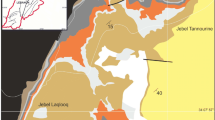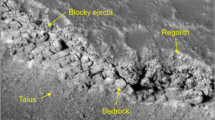Abstract
The examination of speleothems in the Hajnóczy and Baradla caves (northeastern Hungary) allows estimating an upper limit for horizontal peak ground acceleration generated by paleoearthquakes. The density, the Young’s modulus and the tensile failure stress of the samples originating from a broken speleothem have been measured in a laboratory, whereas the natural frequency of intact speleothems was determined by in situ observations. The value of horizontal ground acceleration resulting in failure, the natural frequency and the inner friction coefficient of speleothems were assessed by theoretical calculations. The ages of the samples taken from a stalagmite 5.1 m in height (Baradla cave) have been determined by inductively coupled plasma mass spectrometry analysis and alpha spectrometry. The measured ages fall between 140,000 and 70,000 years; therefore, we assume the speleothem has not been changed since the end of this time interval. According to our modeling results, this speleothem has not been excited by a horizontal acceleration higher than 0.05 g during the last 70,000 years.
Similar content being viewed by others
References
Bada G, Horváth F, Gerner P, Fejes I (1999) Review of the present-day geodynamics of the Pannonian basin: progress and problems. J Geodyn 27:501–527
Becker A, Davenport CA, Eichenberger U, Gilli E, Jeannin P-Y, Lacave C (2006) Speleoseismology: a critical perspective. J Seismol 10:371–388
Cadorin JF, Jongmans D, Plumier A, Camelbeeck T, Delaby S, Quinif Y (2001) Modelling of speleothems failure in the Hotton cave (Belgium). Is the failure earthquake induced? Netherlands J Geosci 80(3–4):315–321
Crispim JA (1999) Seismotectonic versus man-induced morphological changes in a cave on the Arrabida chain (Portugal). Geodin Acta 12:135–142
Delaby S (2001) Paleoseismic investigations in Belgian caves. Netherlands J Geosci 80(3-4):323–332
Ferencz E, Péterfalvi Cs (2002) Investigation of earthquake related vibration and breaking of speleothems (in Hungarian). unpublished manuscript, p 17
Forti P, Postpischl D (1984) Seismotectonic and paleoseismic analyses using karst sediments. Mar Geol 55:145–161
Forti P, Postpischl D (1988) Seismotectonics and radiometric dating of karst sediments. Proc Hist Seismol of Central-eastern Mediterranean Region, ENEA-IAEA Roma, pp 312–322
Gerner P, Bada G, Dövényi P, Müller B, Onescu MC, Cloething SAPL, Horváth F (1999) Recent tectonic stress and crustal deformation in and around the Panonnian basin: data and models. In: Durand B, Jolivet L, Horváth F, Séranne M (eds) The Mediterranean basins: Tertiary extension within the Alpine orogen, vol 156. pp 269–294
Horváth F, Bada G, Windhoffer G, Csontos L, Dövényi P, Fodor L, Grenerczy Gy, Síkhegyi F, Szafián P, Székely B, Tímár G, Tóth L, Tóth T (2006) Atlas of the present-day geodynamics of the Pannonian basin: Euroconform maps with explanatory text (in Hungarian with English summary). Magy Geofiz 47(4):133–137
Jakucs L (1952) The Cave of Aggtelek (in Hungarian). Művelt Nép Könyvkiadó, Budapest, p 118
Kagan EJ, Agnon A, Bar-Matthews M, Ayalon A (2005) Dating large infrequent earthquakes by damaged cave deposits. Geology 33(4):261–264
Kordos L (1984) Caves of Hungary (in Hungarian). Gondolat, Budapest, p 315
Lacave C, Koller MG, Egozcue JJ (2004) What can be concluded about seismic history from broken and unbroken speleothems? J Earthq Eng 8(3):431–455
Lacave C, Levret A, Koller MG (2000) Measurements of natural frequencies and damping of speleothems. Proc. of the 12th World Conference on Earthquake Engineering, Auckland, New-Zealand, paper 2118
Lauritzen S-E, Leél-Őssy Sz (1999) Preliminary age data of certain speleothems from Baradla Cave (in Hungarian). Karszt és Barlang 1994(I-II):3–8
Lenkey L, Dövényi P, Horváth F, Cloething SAPL (2002) Geothermics of the Pannonian basin and its bearing on the neotectonics. In: Cloetingh SAPL, Horváth F, Bada G, Lankreijer A (eds) Neotectonics and surface processes: the Pannonian basin and Alpine/Carpathian system, vol 3. European Geosciences Union, St. Mueller Special Publication Series, pp 29–40
Scholz H (1990) The mechanics of the earthquakes and faulting. Cambridge University Press, p 467
Tóth L, Bus Z, Győri E, Mónus P (2007) Seismicity of the Pannonian basin. In: Husebye E, Christova C (eds) Earthquake monitoring and seismic hazard mitigation in Balkan countries. NATO ARW Series, Springer (in press)
Tóth L, Győri E, Mónus P, Zsíros T (2006) Seismic hazard in the Pannonian region. In: Pinter N, Grenerczy Gy, Weber J, Stein S, Medak D (eds) The Adria Microplate: GPS geodesy, tectonics, and hazards, vol 61. NATO ARW Series, Springer, pp 369–384
Tóth L, Mónus P, Zsíros T, Kiszely M (2002) Seismicity in the Pannonian Region - earthquake data. In: Cloetingh SAPL, Horváth F, Bada G, Lankreijer A (eds) Neotectonics and surface processes: the Pannonian basin and Alpine/Carpathian system, vol 3. European Geosciences Union, St. Mueller Special Publication Series, pp 9–28
Wessel P, Smith WHF (1998) New, improved version of generic mapping tools released. EOS Trans AGU 79:579
Zsíros T (2000) The seismicity and earthquake hazard of the Pannonian basin: Hungarian Earthquake Catalog (456-1995, in Hungarian). MTA GGKI Szeizmológiai Obszervatórium, p 482
Author information
Authors and Affiliations
Corresponding author
Rights and permissions
About this article
Cite this article
Szeidovitz, G., Surányi, G., Gribovszki, K. et al. Estimation of an upper limit on prehistoric peak ground acceleration using the parameters of intact speleothems in Hungarian caves. J Seismol 12, 21–33 (2008). https://doi.org/10.1007/s10950-007-9068-9
Received:
Accepted:
Published:
Issue Date:
DOI: https://doi.org/10.1007/s10950-007-9068-9




